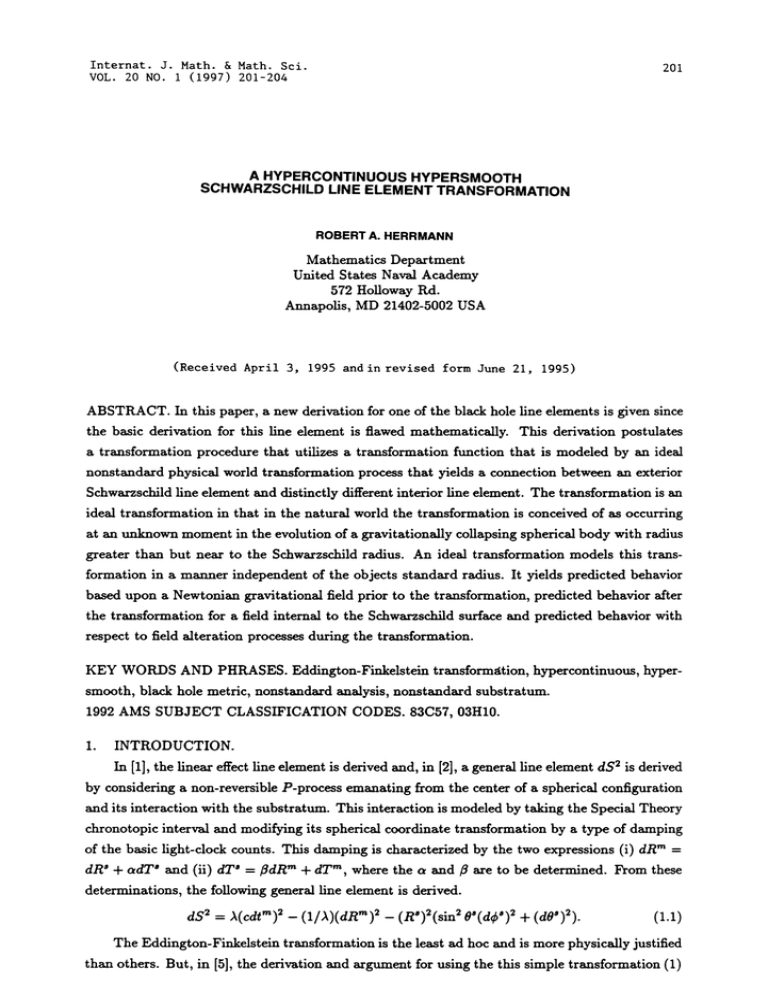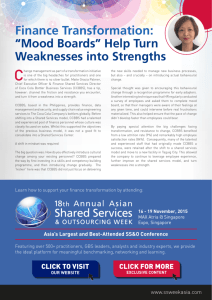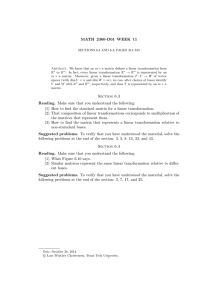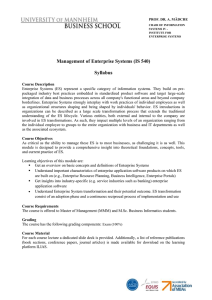Document 10452330
advertisement

Internat. J. Math. & Math. Sci.
(1997) 201-204
VOL. 20 NO.
201
A HYPERCONTINUOUS HYPERSMOOTH
SCHWARZSCHILD LINE ELEMENT TRANSFORMATION
ROBERT A. HERRMANN
Mathematics Department
Uxfited States Naval Academy
572 Holloway Rd.
Annapolis, MD 21402-5002 USA
(Received April 3, 1995 and in revised form June 21, 1995)
ABSTRACT. In this paper, a new derivation for one of the black hole line elements is given since
the basic derivation for this line element is flawed mathematically. This derivation postulates
a transformation procedure that utilizes a transformation function that is modeled by an ideal
nonstandard physical world transformation process that yields a connection between an exterior
Schwarzschild line element and distinctly different interior line element. The transformation is an
ideal transformation in that in the natural world the transformation is conceived of as occurring
at an unknown moment in the evolution of a gravitationally collapsing spherical body with radius
greater than but near to the Schwarzsclfild radius. An ideal transformation models this transformation in a manner independent of the objects standard radius. It yields predicted behavior
based upon a Newtonian gravitational field prior to the transformation, predicted behavior after
the transformation for a field internal to the Schwarzschild surface and predicted behavior with
respect to field alteration processes during the transformation.
KEY WORDS AND PHRASES. Eddington-Finkelstein transformation, hypercontinuous, hypersmooth, black hole metric, nonstandard analysis, nonstandard substratum.
1992 AMS SUBJECT CLASSIFICATION CODES. 83C57, 03H10.
INTRODUCTION.
In [I], the linear effect line element is derived and, in [2], a general llne element d$’ is derived
by considering a non-reversible P-process emanating from the center of a spherical conflguratlon
I.
and its interaction with the substratum. This interaction is modeled by taking the Special Theory
chronotopic interval and modifying its spherical coordinate transformation by a type of damping
of the basic light-clock counts. This damping is characterized by the two expressions (i) dR"
dR" + dT" and (ii) dT" gdR" + dT’, where the and ]9 are to be determined. From these
determinations, the following general line element is derived.
,
aS
(cdt") ’ (1/A)(dR")’ (R)’(sin’ 0(db’) ’ + (dO’)’).
(1.1)
The Eddington-Finkelstein transformation is the least ad hoc and is more physically justified
than others. But, in [5], the derivation and argument for using the this simple transformation (1)
202
R.A. HERRMANN
dU"’ dr" + .fM(R’)dR" to obtain a black hole line element is flawed. This flaw is caused by
the usual ad hoc logical errors in "removing infinities." Equation 57.11 in [5, p. 157], specifically
requires that R > 2GM/c 2. However, in arguing for the use of the transformed Schwarzschild
line element (1.1), Lawden assumes that it is possible for R" 2GM/c But the assumed real
valued function defined by equation 57.11 is not defined for R" such that R
2GM/c2. Since
the derivation of the Schwarzschild line element in [2] does not require the General Principle
of Relativity and, indeed, assumes that there is a privileged observer within a substratum, a
new and rigorously correct procedure is necessary. This is accomplished by showing that (1)
can be considered as a hypercontinuous and hypersmooth transformation associated with a new
non-reversible P-process that yields an alteration to the gravitational field in the vicinity of the
Schwarzschild surface during the process of gravitational collapse. This speculation is modeled
by the expression (1) which is conceived of as an alteration in the time measuring light-clock.
Further, this alteration is conceptually the same as the ultrasmooth microeffects model for fractual
behavior [4]. This transformation takes the Schwarzschild line element, which applies only to the
case where R" > 2GM/c2, and yields an NSP-world black hole line element that only applies for
the case where R" < 2GM/c Like ultrasmooth microeffects, the nonstandard transformation
process is considered as an ideal model of behavior that approximates the actual natural world
process. Thus we have two district line dements connected by such a transformation and each
applies to a specific R’ domain.
2. THE FUNCTION f(R’).
To establish that an internal function fM(Rm) exists with the appropriate properties proceed
as follows: let be the set of all nonsingleton intervals in (at). Let
C (at lit) be the set
let C(I, at) C be the set of all
of all nonempty functional sets of ordered pairs. For each I
real valued continuous functions (end points included as necessary) defined on I. For each a > 0,
]f. 6 C((-oo, 0], at), (-oo,0] fi 2r, such that Vz 6 (-oo,0], f.(z) 1/(z -a). Further, Bg. fi
such that Vz (0,2a], g.(z) -z/(2a ) + 7z2/(4a ) z/a
1/a.
C((0,2a], at), (0,2a]
Then Bh. C((2a, +cx),at), (2a, +oo) (5 ’, such that Vz (2a, +cx), h.(x)
0. Finally, it
follows that limz--.o- ft(x) lim,--.o+ ga(x), lim,_.2,- ga(x) limt.-.2,4 ha(x). Hence
.
.
, " "
,
n.(=)
’.(=);
9.(=);
(-oo, o]
(0,2a]
x fii (2a, +co)
z
is continuous for each z E at and has the indicated properties.
Now (z) exists and is continuous for all x E at and
H:
f:();
n:()
:();
:();
e (-oo, 0]
(0,2a]
e (2., +oo)
All of the above can be easily expressed in a first-order language and all the statements
hold in our superstructure enlargement [4]. Let 0 <
tt(0). Then there exists an internal
-,
q
*t such that Vz
hypercontinuous hypersmooth H,: *at
*(-oo,0], H,(z) 1/(z- ) and
Yz q *(-oo,0)t3 at, st(H,(z)) st(1/(z -)) 1/z; and for z 0, H,(0) exists, although
t(H,(0)) does not exist as a real number. Further, Yz q (2, +oo)t3at (0, +oo), st(H,(z)) O.
To obtain the hypercontinuous hypersmooth fM, simply let c.fM H,, x A, R" *at.
SCHWARZSCHILD LINE ELEMENT TRANSFORMATION
3.
MOTIVATION FOR FUNCTION SELECTION.
f defined on interval I is standardizable (to F)
Recall that a function
203
on
I if ’x E I rl
lit, F(x) sv.(f(x)) r= lit. Now, consider the transformation (1) in the nonstandard form dU
dt + fM(R)dR where internal fM(R’) is a function defined on A C *lit, and A A(R’).
There are infinitely many nonstandard functions that can be standardized to produce the line
element d’2. In this line element, consider substituting for the function A A(R m, the function
*A- e. The transformed line element then becomes, prior to standardizing the coefficient functions
(i.e. restricting them the the natural world),
T
*A
e)c’((dU) 2 2fMdUdR + fw(dR) ’) (1/( *A e))(dRm) ’(R")2(sin’ O(d’) + (dO") )
*A e)ce(dUm) ’ 2( *A e)c’fMdUmdR+
(( "A
e)c’ fw (1/( *A e)))d: dR"(R’)’(sin’ 0re(de’) ’ + (dO")’).
(3.1)
Following the procedure outlined in [4], first consider the partition IR (-o0, 0] U (0, 2e] U
(2e, +), where e is a positive infinitesimal. Consider the required constraints. (2) As required,
for specific real intervals, all coefficients of the terms of the transformed line element are to be
standardized and, hence, are standard functions. (3) Since any line element transformation, prior
to standardization, should retain its infinitesimal character with respect to an appropriate interval
I, then for any infinitesimal dR and for ea value R E I terms such as G(R)dR where
G(Rm) is a coefficient function, must be of infinitesimal value.
For the important constraint (3), Deilnition 4.1.1, and theorems 4.1.1, 4.1.2 in [3] imply that
for a fixed infinitesimal dR in order to have expression b infinitesimal as R varies, the coefficient
h(R)
"A-e)c’fw 1/(*A-e) must be infinitesimal on a subset A of an appropriate interval
I such that 0 E A. The simplest case would be to assume that A
*( -o, 0]. Let standard
r e A t3 IR. Then it follows that h(r) C p(0). Thus st(h(r))
0. Inleed, let x e (tg{ft(r) r <
we
r
are seeking a transformation process that
0, e lit}) t9 (p(0) f3 A). Then st(h(x)) 0. Since
is hypercontinuous, at least on *( c, 0], this last statement suggests the simplest to consider
would be that on *(- oo,0], h
0. Thus the basic constraint yields the basic requirement
that on *(- o,0] the simplest function to choose is CfM(X)
1/(x --e). Since standardizing
is required on *(- o,0)rl lit, we have for each x e "(- o,0)f3 IR, that st(cfM(x))
cst(fM(X)) st(1/(x- e)) 1/X. This leads to the assumption that on (-o,0] the function
f(x) 1/(x a), a > 0, should be considered. After *-transferring and prior to standardizing,
this selection would satisfy (3) for both of the coefficients in which fM appears and for the
interval I
*(- oo, 0]. The function ga is arbitrarily selected to satisfy the hypercontinuous
and hypersmooth property and, obviously, ha is selected to preserve the original line element for
the interval (2e, +oo). Finally, it is necessary that the resulting new coefficient functions, prior
to standarizing, all satisfy (3) at least for a fixed dR and a varying R E *( -o, 0] for the
expression (1). It is not difficult to show that IH,(x)l < 2/e for all x e *IR. Consequently, for
e (dRY) 1/3 expression (1) is an infinitesimal for all R" e *IR.
,
R.A. HERRMANN
20
,
v2/c2
A. For the collapse scenario R
RM. If 2GM/(R’c2) < 1, substituting
v into (1.1) yields the so-called Schwarzschild line element. With respect to the
2GM/R
1- 2GM/(R’’c); for
transformation, (A) if R" < 2GM/c then for st(fM(R")) 1/(cA),
(B) R" > 2GM/c2; s’C(fM(R")) 0, and for the case that (C) R" 2GM/c the function fM
is defined and equal to a NSP-world value fM(R’). But, for case (C), st(fM(R’)) does not exist
as a real number. Hence, (C) has no direct effect within the natural world when R" 2GM/c2,
although the fact that fM(R")dR" is an infinitesimal implies that s’c(fM(R’)dR ’) 0. Using
these NSP-world functions and (3.1), cases (A) and (C) yield
Let I
,
,
dS[ $(cdU’)
2cdU" dR"-
(n-)(i= 0-(d-) + (dO’)).
(3.2)
But case (B), leads to (1.1). The two constraints are met by fM(R"), and indeed the standardized
(A) form for fM(R’) is unique if (3)
is to be satisfied for a specific interval.
Since this is an ideal approximating model, in order to apply this ideal model to the natural
vorld, one most select an appropriate real a for the real valued function Ha. Finally, it is not
assumed that the function ga is unique. In any solutions for hne dement (3.2), the dU" [resp.
dR’] refers to the timing [resp. length] infinitesimal light-clock counts and does refer to universal
time [resp. length] alterations.
REFERENCES
1.
HERRMANN, R.A. An operator equation and relativistic alterations in the time for radioactive
decay, Intern, J. Math. Math. Sci., (to appear).
2.
HERRMANN, R.A. Constructing Logically Consistent Special and General Theories of
.Relativity, Math. Dept., U.S. Naval Academy, Annapolis, MD, 1993.
3.
HERRMANN, R.A. Some application of nonstandard analysis to undergraduate mathematics:
infinitesimal modeling and elementary_ physics, Instructional Development Project,
Mathematics Department, U. S. Naval Academy, AnnapoliS, MD, 21402-5002, 1991.
4.
HER_RMANN, R.A. Fractals and ultrasmooth microeffects, J. Math. Phys., 30(April 1989),
805-808.
5.
LAWDEN, D. F. A_.n Introduction to Tensor Calculus, Relativity and Cosmology, John Wiley
& Sons, New York, 1982.





